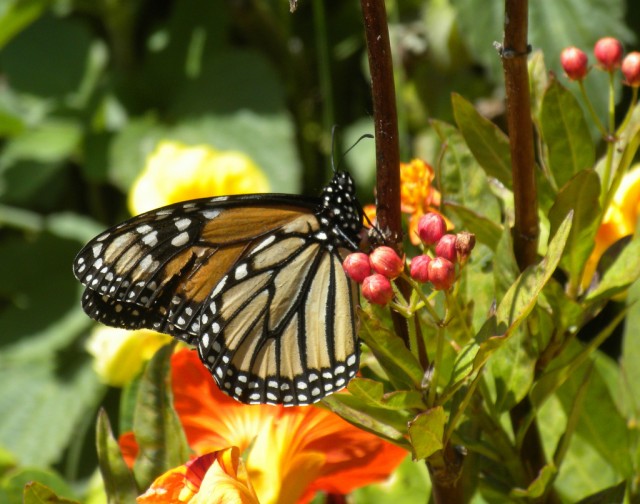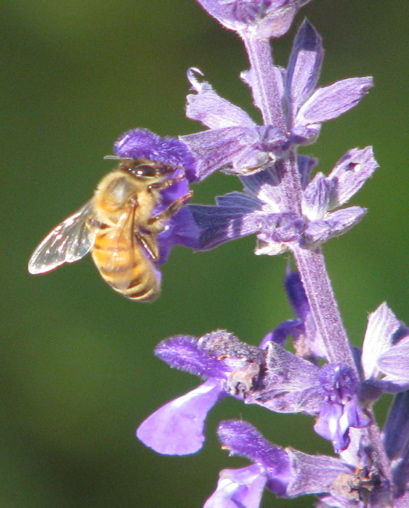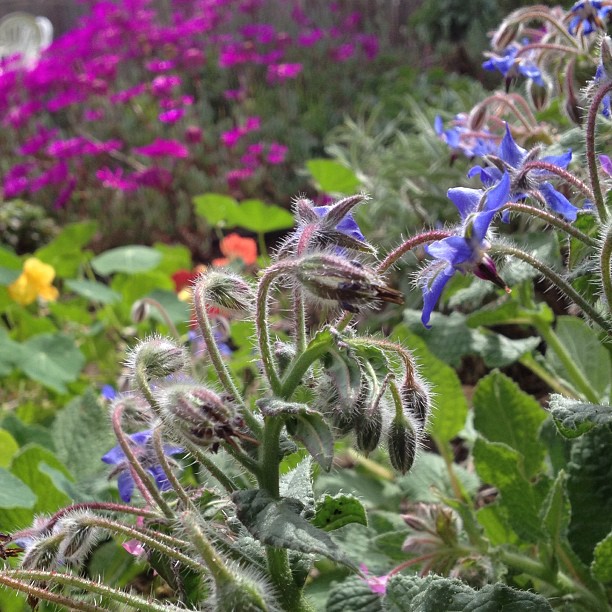Posts Tagged ‘bees’

I’ve been blogging about Monarch butterflies practically from the moment this blog began. I’ve been growing milkweed, the only host plant for monarch caterpillars, in our yard for over a decade—first in Crozet, Virginia, and then here in San Diego after our move seven years ago. When you leave a comment on this blog, if you don’t happen to have a WordPress avatar set up, the default avatar is a picture of milkweed from my garden. I made a very dopey video, once, showing some of our butterfly plants, and was lucky enough to catch a Monarch in the act of laying an egg on the underside of a leaf. We’ve been a family wrapped up in bees and butterflies for a very long time.
We had a fair number of caterpillars last year, enough to eat our five plants to the ground. But this year may be different.
This year, the giant Monarch migration that takes place in the mountains of Mexico has been, well, not exactly giant.
…for the first time in memory, the monarch butterflies didn’t come, at least not on the Day of the Dead. They began to straggle in a week later than usual, in record-low numbers. Last year’s low of 60 million now seems great compared with the fewer than three million that have shown up so far this year. Some experts fear that the spectacular migration could be near collapse.
The reasons aren’t a mystery:
A big part of it is the way the United States farms. As the price of corn has soared in recent years, driven by federal subsidies for biofuels, farmers have expanded their fields. That has meant plowing every scrap of earth that can grow a corn plant, including millions of acres of land once reserved in a federal program for conservation purposes.
Another major cause is farming with Roundup, a herbicide that kills virtually all plants except crops that are genetically modified to survive it.
As a result, millions of acres of native plants, especially milkweed, an important source of nectar for many species, and vital for monarch butterfly larvae, have been wiped out. One study showed that Iowa has lost almost 60 percent of its milkweed, and another found 90 percent was gone. “The agricultural landscape has been sterilized,” said Dr. Brower.
This article touches, too, on the dire plight of the honeybee, about which I’ve had much to say on this blog over the years.
I don’t often feel helpless. But with this, I do. What can I do beyond the small acts I’ve been doing? Planting milkweed, singing the joys of bee-and-butterfly gardening, avoiding pesticides and herbicides even though that means I have a weedy garden. Keep on singing, I guess?

I know I’ve been singing this song for a long time, y’all, but it’s bad, bad, bad and getting worse.
Soaring Bee Deaths in 2012 Sound Alarm on Malady – NYTimes.com
“They looked so healthy last spring,” said Bill Dahle, 50, who owns Big Sky Honey in Fairview, Mont. “We were so proud of them. Then, about the first of September, they started to fall on their face, to die like crazy. We’ve been doing this 30 years, and we’ve never experienced this kind of loss before.”
When beekeepers and scientists first starting investigating colony collapse disorder, causes were uncertain. Rowan Jacobsen’s excellent book, Fruitless Fall, explores possible reasons. (Here’s one of my many posts about the book.)
Five years later, we have a much clearer idea of exactly what is happening, and it’s very bad news.
But many beekeepers suspect the biggest culprit is the growing soup of pesticides, fungicides and herbicides that are used to control pests.
While each substance has been certified, there has been less study of their combined effects. Nor, many critics say, have scientists sufficiently studied the impact of neonicotinoids, the nicotine-derived pesticide that European regulators implicate in bee deaths.
The explosive growth of neonicotinoids since 2005 has roughly tracked rising bee deaths.
Neonics, as farmers call them, are applied in smaller doses than older pesticides. They are systemic pesticides, often embedded in seeds so that the plant itself carries the chemical that kills insects that feed on it.
The pesticide is embedded in the seeds. I posted to another piece on this topic this last week, and these are just a couple of the many anxious reports I’ve picked up on my bee wire (Google Alerts, when they’re working) in the past few months. I know I’m probably preaching to the choir here, but I implore you to read up on this issue, if you haven’t yet, and to spread the word far and wide. If we lose the bees, we lose the world as we know it.

“Without honeybees, we may cease to be”
Fruitless Fall


More of my love letters to bees:
All my photos look the same
Petal nests
Fruitless Fall
Oh, for a bee’s experience
Fairy dust
And yet.

Via Light reading: Osmia avosetta bees make petal-nests for their larvae.
O. avosetta bees at National Geographic: “Flower sandwich”
At Daily Croissant:
What appears to be part of a spring wedding bouquet is actually a nest for a rare species of solitary bee, a new study says.
Called a “flower sandwich,” the three-tiered arrangement consists of a thin layer of petals on the outside, then a layer of mud, and finally another layer of petals lining the inside of the chamber…
At Discovery News:
Although O. avosetta was known to science, no one had ever had a chance to study its behaviors. Bees don’t advertise their nests, Rozen said, and this species is only active for about two months out of the year.
But in a lucky coincidence, two teams in two different countries discovered the nest-building habits on the same day. Rozen was working with a team of entomologists in Turkey last May, while another team was studying the bees in Iran. The groups collaborated on a recent paper published in American Museum Novitates.
At Beekeeping Times:
“It was absolute synchronicity that we all discovered this uncommon behavior on the same day,” says Jerome Rozen, curator in the Division of Invertebrate Zoology at the American Museum of Natural History. Rozen and colleagues were working near Antalya, Turkey while another group of researchers were in the field in Fars Province, Iran.
This site has a photo of a bee carrying a petal to the nest, but it’s too small to make out much. I would love to see video of how the bees manage this feat.
…all my photos look the same.

Same salvia, same bees, same blur.

Can’t be helped. I am powerless to resist those blues, those greens, those coppery wings, this pointed face buried in blossom.

You understand, don’t you?
(You’re just lucky I’m not into spiders.)

It has been troubling me in a quiet way that I’ve not seen many bees in the garden this spring: an occasional lone native bee, one carpenter bee, and that’s it. But just now I checked my archives and I see I was worried about the same thing in late April last year. The carpenter bee appeared in early May, and it wasn’t until mid-May that the honeybees began to dominate my posts and pictures.
Whew, then.
I did have sunflowers blooming last April, but the birds had planted those in February: overspill from the feeder. This year the feeder is in a different spot, shadier, unwatered, and I had to plant the sunflowers myself. They’re coming up nicely, taller now than Wonderboy, not as tall as Beanie.
The Monarchs arrived in late May, not long after I planted my anniversary milkweed. The milkweed is blooming nicely now, despite hordes of yellow aphids, but we’ve seen no trace of caterpillar nor butterfly yet.
Also in bloom: pincushion flower (just barely), nasturtiums galore, enough sweet alyssum to supply Rilla with endless bridal bouquets for her daily weddings, geraniums in red and pink, cornflowers, bougainvillea, ice plants in red and white and magenta, snapdragons, brown-eyed susans, thyme (whoops), cilantro (whoops), the cooking sage (whoops), and the other kind of salvia, loads of it, waiting for the bees.
Goldfinches, bushtits, purple finches, sparrows, hummingbirds, a phoebe, and the marvelous crows: our April birds. We saw a scrub jay on the sidewalk today, a block from home. I love jays, the cheeky, arrogant things. I wish they’d visit our yard more often.
February 13, 2010 @ 9:22 am | Filed under:
Links 











